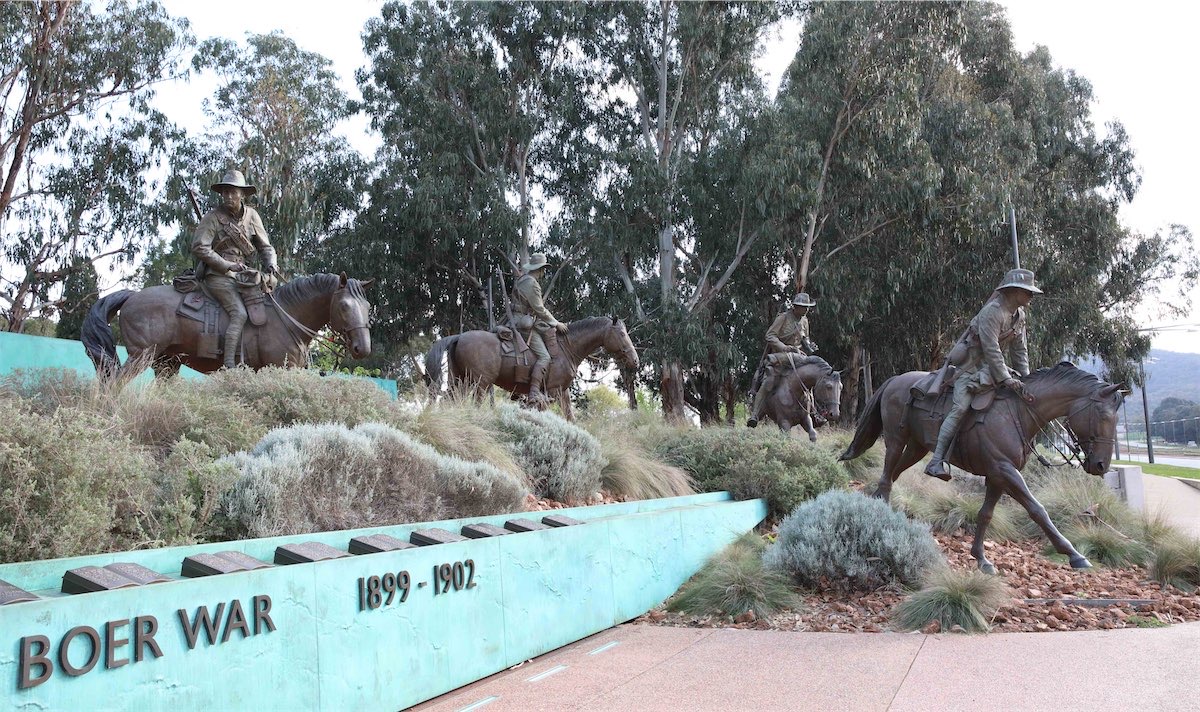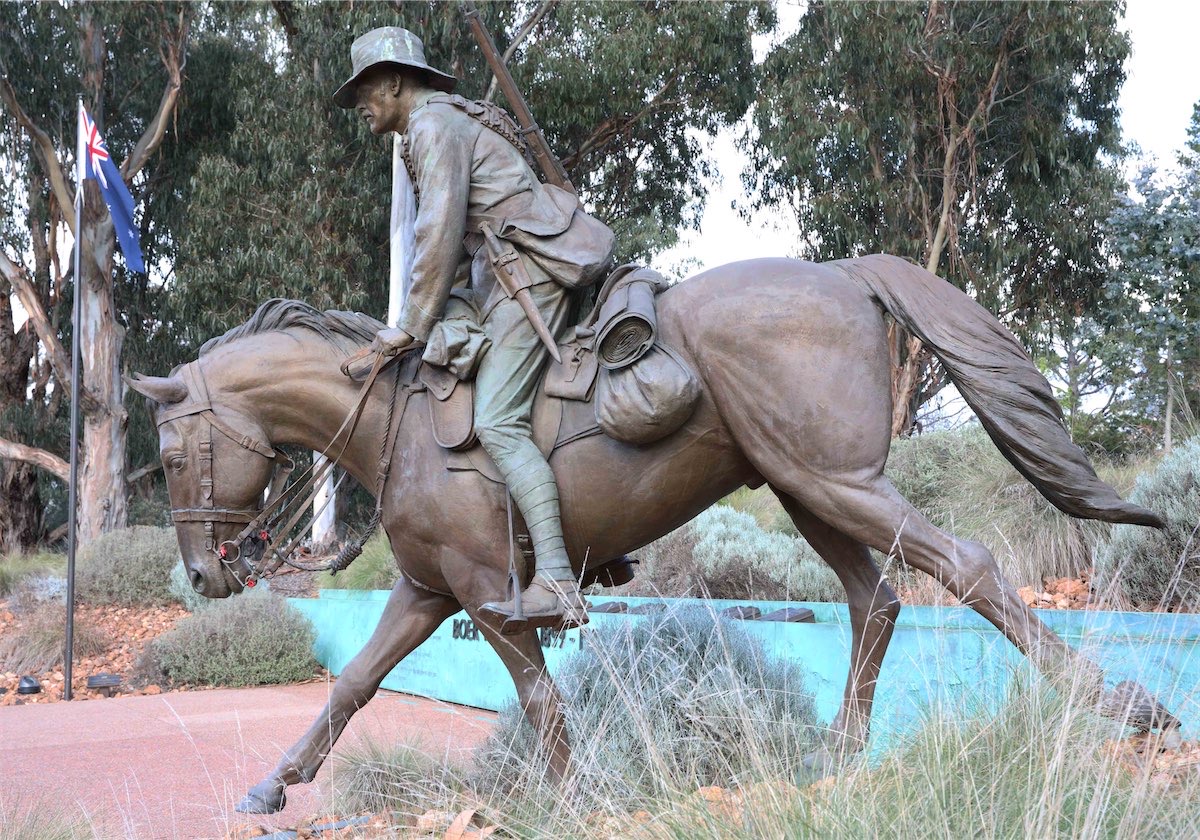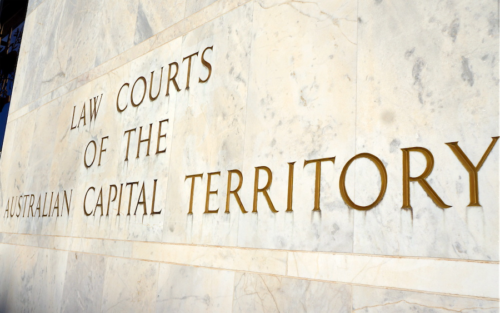
The Boer War memorial on Anzac Parade… It consists of a diorama of four mounted men riding through the veldt. The bronze sculptures and the landscape are in the artistic tradition of figurative realism. Photo: Con Boekel
“The pristine veldt in the diorama lacks burning houses and crops, dead horses, dead sheep, field hospitals choked with soldiers dying of disease… and civilians dying in British concentration camps,” writes CON BOEKEL.
THE Boer War, our first national war, is memorialised on Anzac Parade – a national place.

The memorial consists of a diorama of four mounted men riding through the veldt. Memorial texts include poetry by Banjo Paterson, letters home from Private FH Booth and official interpretation.
The bronze sculptures and the landscape are in the artistic tradition of figurative realism. There is accurate detail with respect to tack, badges, equipment and uniforms. Black patination on the horses’ tails and khaki patination on the uniforms add to the realism. The diorama landscape mimics the veldt. Visual claims to representing realism are complemented by the interpretative texts.
The technical aspects of Louis Laumen’s sculpting and of the bronze casting are excellent. The sure-footed and curved flow of horses and men down a slight slope, along with the distribution of shapes, mass and negative spaces, combine to generate considerable aesthetic appeal. The values exhibited in the diorama are courage, willingness to sacrifice life, and military skill.
The emphasis on realism raises the question: “What were the realities of the Boer War?” Here, elements of the texts diverge from the diorama. Banjo Paterson wonders whether the war is “worth” the wounded and the dead. Booth refers to the large number of sick soldiers. Booth also expresses disquiet about burning crops and herding women and children away from their homes, but omits the systematic house burning, and the killing and looting of livestock. The interpretative texts refer to the numerous “civilians” who died in British concentration camps.
The interpretative texts omit mention of domestic Australian civilian opposition to the war and to elements of its conduct. Also missing is the cause of the war, which was the British determination to capture the Rand goldfields. There is no reference to Africans.
The interpretative texts provide three whole-of-war statistics: decorations awarded to Australians (167), Australians who joined (23,000), and Australians who died (1000).
The texts omit the following statistics: Boer fighters killed (6000), Boer women and children deaths in British concentration camps (26,000), African civilian deaths in British concentration camps (20,000), Boer farm houses burned (30,000), Boer sheep killed (3,500,000), and horse deaths on the Imperial side (300,000).
The Hague Convention of 1899 forbade the killing of enemy combatants who had surrendered, looting and collective punishment.
Thomas Pakenham in his magisterial “The Boer War” states: “It was an open secret that some of the irregular colonial forces made it a principle not to take prisoners.”
Breaker Morant’s Bushveldt Carbineers was one such force. Pakenham contrasts this with the military value and good conduct of the regular Australian contingents.
 The four horses in the diorama are heroic in scale and magnificently fit. The service life expectancy of a horse was six weeks. Most died from disease, starvation and exhaustion. The pristine veldt in the diorama lacks burning houses and crops, dead horses, dead sheep, field hospitals choked with soldiers dying of disease, barbed wire, block houses, armoured trains, and civilians dying in British concentration camps.
The four horses in the diorama are heroic in scale and magnificently fit. The service life expectancy of a horse was six weeks. Most died from disease, starvation and exhaustion. The pristine veldt in the diorama lacks burning houses and crops, dead horses, dead sheep, field hospitals choked with soldiers dying of disease, barbed wire, block houses, armoured trains, and civilians dying in British concentration camps.
The application of figurative realism, the artistic beauty of the diorama, the limited diorama subjects, the limited statistics, and the limited ambit of the interpretative texts, taken together, do not provide a realistic or representative picture of the Boer War.
This raises a key question: “How should a nation memorialise skill, courage and self-sacrifice delivered in the service of a war that was waged for gold, and the conduct of which included systemic elements that did not meet our then national values?”
We have come a long way. Our values are now expressed in the Rules of Engagement (ROE) of the Australian Defence Force. I believe that the vast majority of ADF personnel observed the ROE with skill, courage and dedication during the two decades of our latest national war, the Afghanistan War. This deserves memorialisation.
How might shortcomings raised by Boer War memorialisation help inform an Australian Afghanistan War Memorial?
Con Boekel majored in history at Monash University in 1968 and has not stopped reading history since. He has an abiding personal interest in how war is presented and mis-represented.
Who can be trusted?
In a world of spin and confusion, there’s never been a more important time to support independent journalism in Canberra.
If you trust our work online and want to enforce the power of independent voices, I invite you to make a small contribution.
Every dollar of support is invested back into our journalism to help keep citynews.com.au strong and free.
Thank you,
Ian Meikle, editor





Leave a Reply